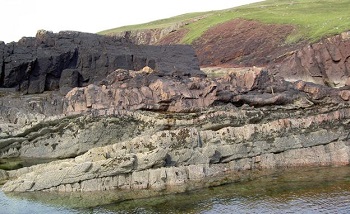Scientists think the time has come for a full geophysical survey of The Minch, to see if the Scottish strait is hiding an ancient meteorite crater.
The idea that such a structure lies between the Western Isles and mainland Scotland was first raised back in 2008.
They found evidence on the Highlands coast for the rocky debris that would have been produced by a giant impact.
Now, the researchers believe it can pinpoint where the space object fell to Earth.
Doctors say this location is centered about 15-20km west-northwest of Enard Bay – part way across The Minch towards Stornoway in the Outer Hebrides.
It’s an intriguing prospect. The evidence gathered so far suggests the event occurred about 1.2 billion years ago when the continents were arranged very differently from how they are now, and life on our planet would have existed almost exclusively in the oceans.
The key supporting evidence is a group of reddish-coloured rocks on the eastern side of The Minch known as the Stac Fada deposit.
These are determined to be ejecta from the impact – the material hurled outwards when a 1-2km-wide object slammed into what was probably then some kind of rift valley.
The rocks are fragmented and contain melt particles, and also what geologists term shocked quartz – a type of mineral that has at some point been subjected to enormous pressures.
Shocked quartz is very often associated with meteorite events.
The latest examinations of the Stac Fada deposit have now given the researchers some directional information that allows them to be more precise about where the ejecta came from.
“If you imagine debris flowing out in a big cloud across the landscape, hugging the ground, eventually that material slows down and comes to rest. But it’s the stuff out in front that stops first while the stuff behind is still pushing forward and it overlaps what’s in front,” explained the researchers.
“That’s what we see and it gives us a strong directional indicator that we can trace backwards.
“Also, we’ve examined the orientation of magnetic particles within the fabric of the rock at several locations, and this too allows us to triangulate back to an origin,” the Oxford researcher told BBC News.
The lines converge out in The Minch.
Lara Khouli

